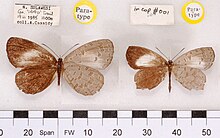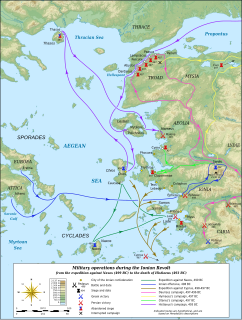| Miletus rosei | |
|---|---|
 | |
| Scientific classification | |
| Kingdom: | |
| Phylum: | |
| Class: | |
| Order: | |
| Family: | |
| Genus: | |
| Species: | M. rosei |
| Binomial name | |
| Miletus rosei Cassidy, 1995 [1] | |
Miletus rosei is a butterfly in the family Lycaenidae. It is found in northern Sulawesi.
| Miletus rosei | |
|---|---|
 | |
| Scientific classification | |
| Kingdom: | |
| Phylum: | |
| Class: | |
| Order: | |
| Family: | |
| Genus: | |
| Species: | M. rosei |
| Binomial name | |
| Miletus rosei Cassidy, 1995 [1] | |
Miletus rosei is a butterfly in the family Lycaenidae. It is found in northern Sulawesi.

Anaximenes of Miletus was an Ancient Greek, Ionian Pre-Socratic philosopher from Miletus in Asia Minor, active in the latter half of the 6th century BC. The details of his life are obscure because none of his work has been preserved. Anaximenes' ideas are only known today because of comments about him made by later writers, such as Aristotle.

Isidore of Miletus was one of the two main Byzantine Greek architects that Emperor Justinian I commissioned to design the cathedral Hagia Sophia in Constantinople from 532 to 537. The creation of an important compilation of Archimedes' works has been attributed to him. The spurious Book XV from Euclid's Elements has been partly attributed to Isidore of Miletus.

Ionia was an ancient region on the central part of the western coast of Anatolia in present-day Turkey, the region nearest İzmir, which was historically Smyrna. It consisted of the northernmost territories of the Ionian League of Greek settlements. Never a unified state, it was named after the Ionian tribe who, in the Archaic Period, settled mainly the shores and islands of the Aegean Sea. Ionian states were identified by tradition and by their use of Eastern Greek.

Miletus was an ancient Greek city on the western coast of Anatolia, near the mouth of the Maeander River in ancient Caria. Its ruins are located near the modern village of Balat in Aydın Province, Turkey. Before the Persian invasion in the middle of the 6th century BC, Miletus was considered among the greatest and wealthiest of Greek cities.

Priene was an ancient Greek city of Ionia located at the base of an escarpment of Mycale, about 6 kilometres (3.7 mi) north of what was then the course of the Maeander River. It was 67 kilometres (42 mi) from ancient Anthea, 15 kilometres (9.3 mi) from ancient Aneon and 25 kilometres (16 mi) from ancient Miletus. The city was built on the sea coast, overlooking the former Latmian Gulf of the Aegean. It was developed on steep slopes and terraces extending from sea level to a height of 380 metres (1,250 ft) above sea level at the top of the escarpment. Because of siltation from the river filling the bay over several centuries, the city is now an inland site. It is located at a short distance west of the modern village Güllübahçe Turun in the Söke district of Aydın Province, Turkey.
Hecataeus of Miletus, son of Hegesander, was an early Greek historian and geographer.

The Ionian Revolt, and associated revolts in Aeolis, Doris, Cyprus and Caria, were military rebellions by several Greek regions of Asia Minor against Persian rule, lasting from 499 BC to 493 BC. At the heart of the rebellion was the dissatisfaction of the Greek cities of Asia Minor with the tyrants appointed by Persia to rule them, along with the individual actions of two Milesian tyrants, Histiaeus and Aristagoras. The cities of Ionia had been conquered by Persia around 540 BC, and thereafter were ruled by native tyrants, nominated by the Persian satrap in Sardis. In 499 BC, the tyrant of Miletus, Aristagoras, launched a joint expedition with the Persian satrap Artaphernes to conquer Naxos, in an attempt to bolster his position. The mission was a debacle, and sensing his imminent removal as tyrant, Aristagoras chose to incite the whole of Ionia into rebellion against the Persian king Darius the Great.

For war between the navy of Rhodes and the navy of Macedon in 201 BC, see Battle of Lade.

Histiaeus, the son of Lysagoras, was a Greek ruler of Miletus in the late 6th century BC. Histiaeus was a Tyrant under Darius I, king of Persia, who had subjugated Miletus and the other Ionian states in Asia Minor, and was in the habit of appointing Greek tyrants to rule the Greek cities of Ionia in his territory.

Didyma was an ancient Greek sanctuary on the coast of Ionia in the domain of the famous city of Miletus. Apollo was the main deity of the sanctuary of Didyma, also called Didymaion. But it was home to both of the temples dedicated to the twins Apollo and Artemis. Other deities were also honoured within the sanctuary. The Didymaion was well renowned in antiquity because of its famed oracle. This oracle of Apollo was situated within what was, and is, the one of the world's greatest temples to Apollo. The remains of this Hellenistic temple belong to the best preserved temples of classical antiquity. Besides this temple other buildings existed within the sanctuary which have been rediscovered recently; a Greek theatre and the foundations of the above-mentioned Hellenistic temple of Artemis, to name but two.

The Ionian school of Pre-Socratic philosophy was centred in Miletus, Ionia in the 6th century BC. Miletus and its environs was a thriving mercantile melting pot of current ideas of the time. The Ionian School included such thinkers as Thales, Anaximander, Anaximenes, Heraclitus, Anaxagoras, and Archelaus. The collective affinity of this group was first acknowledged by Aristotle who called them physiologoi (φυσιολόγοι), meaning 'those who discoursed on nature'. The classification can be traced to the second-century historian of philosophy Sotion. They are sometimes referred to as cosmologists, since they were largely physicalists who tried to explain the nature of matter.
Cyclic Poets is a shorthand term for the early Greek epic poets, approximate contemporaries of Homer. No more is known about these poets than about Homer, but modern scholars regard them as having composed orally, as did Homer. In the classical period, surviving early epic poems were ascribed to these authors, just as the Iliad and Odyssey were ascribed to Homer. Together with Homer, whose Iliad covers a mere 50 days of the war, they cover the complete war "cycle", thus the name. Most modern scholars place Homer in the 8th century BC. The other poets listed below seemed to have lived in the 7th–5th centuries BC. Excluding Homer's, none of the works of the cyclic poets survive.

Miletus is a genus of butterflies sometimes called brownies. Its species are found in the eastern Palearctic realm and the Indomalayan realm, and some stray east of the Wallace Line. The genus was erected by Jacob Hübner around 1819. Miletus is the type genus of the subfamily Miletinae.
A Delphinion found in ancient Greece, was a temple of Apollo Delphinios also known as "Delphic Apollo" or "Pythian Apollo", the principal god of Delphi, who was regarded as the protector of ports and ships.

Myus, sometimes Myous or Myos, was an ancient Greek city in Caria. It was one of twelve major settlements of the Ionian League. The city was said to have been founded by Cyaretus, a son of Codrus. Myus was located on a small peninsula at the coast of the Aegean Sea, but it now lies inland due to the sediment deposited by the Maeander River over many centuries. The site of the city lies north of the modern village Avşar in the Söke district of Aydın Province, Turkey
The Yunnan red-backed vole is a species of rodent in the family Cricetidae. It is found in Southwest China, specifically Yunnan Province. It is the largest member of the genus Eothenomys, with a higher cranium, a soft, thick and long coat with tawny brown to reddish brown coloring and grey underparts.

The Siege of Miletus was Alexander the Great's first siege and naval encounter with the Achaemenid Empire. This siege was directed against Miletus, a city in southern Ionia, which is now located in the Aydın province of modern-day Turkey. During the battle, Parmenion's son Philotas would be key in preventing the Persian Navy from finding safe anchorage. It was captured by Parmenion's son, Nicanor in 334 BC.
Limnae or Limnai, was an ancient Greek city dating back to 7th century B.C. on the Gallipoli peninsula. The city was founded by migrants coming from Ionia. The city was one of the richest and most busy seaports of the Gallipoli region in its time and maintained its existence until the Roman era.
Pidasa or Pedasa (Πήδασα) was a town of ancient Caria. During the Ionian Revolt, the Persians suffered a defeat at Pidasa. It was once the chief seat of the Leleges. It was a polis (city-state) and a member of the Delian League. In the time of Strabo the town had ceased to exist, and the name of the district, Pedasis (Πηδασίς), was the only remaining memorial of the place. As Herodotus assigns to Pedasa a portion of the territory of Miletus, it is clear that the town must have been situated between Miletus, Halicarnassus, and Stratoniceia.
| Wikimedia Commons has media related to Miletus rosei . |
| Wikispecies has information related to Miletus rosei . |
| This Miletinae-related article is a stub. You can help Wikipedia by expanding it. |